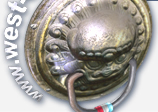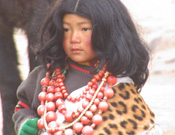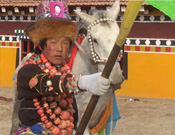| Fantastic Tibetan New Year Festivals
In Repkong (Tongren) and Ngawa (Aba) Amdo (16 days)
Day 1.
Arrive in Beijing or Chengdu in the morning and then fly to Xining
(Alt: 2200m), capital city of Qinghai Province. Free and have a
rest. Qinghai Hotel.
Day 2.
Drive 150km via Sun and Moon Mountain Pass (Tib: Riwo Nyida, Alt:
3520m. Gate of the grassland and was once border of Tibet) to Kokonor
Lake. The reason I arrange Kokonor, because she presents fantastic
scenery in wintertime and it is not so cold. At this season, lake
surface is frozen from December to 5th or 10th of April every year.
If clients like, we can drive back through north road to Xining,
all round trip is 520km, Altitude is between 3200m to 3600m. 9 hours
driving including stops for photos and 2/3 is grassland view. Or
be prepared for some surprises, we can take a new and shorter high
way along the north east Lake through a large sand dunes area and
another beautiful valley back to Xining. Road condition is all-good.
Overnight Qinghai Hotel.
Day 3.
In the morning, we visit the important and famous monastery Kumbum.
After lunch we drive to Repkong(Chin: Tongren. Alt: 2400m). Huangnan
hotel. (Warm and clean)
Day 4.
Drive 5km to Upper Wutun monastery (Tib: Sengeshong Yago), a famous
monk art school set up in 16th century. Now it has 90 monks, the
youngest is 7 years old and all of them have a good training to
be artists in this monastery. You can find their art works such
as paintings and sculptures almost in whole Tibetan area. Masks
dance by monk artists here is wonderful. The main theme of the performances
is to describe how do all the Protector Deities kill the devil spirits
that is made of barley flowers in a box (Tib: Tukchuwa, means bad
things need to be thrown away). The best part is to see monks burning
the devil things at the end of Dance in the field near the monastery.
You can not imagine how happy the whole village people are when
seeing the Tukchuwa is burning and hundreds of village men let off
countless firecrackers together! At the moment in this atmosphere,
you can create a strong feeling of self-confidence towards New Year.
It seems no any difficulties can stop your steps to a bright future.
Day 5.
In the morning, we visit some important monasteries in different
villages. Afternoon we go to see The Sunning the Buddha in Upper
Wutun ( Sengeshong Mago).
Day 6.
We drive 7Km to Guomar village to see Sunning the Buddha. The whole
process is exiting. As this grand event happens only once a year,
all the village people are eager to do prostration in front of big
Tangkha of Buddha which is 40m long and 20m wide, at the beginning
of the year to thank Buddha for the passed year and to pray for
good things in the coming year.
Day 7.
Drive 4 hours through a very nice valley to Labrang monastery. The
valley looks like "Grand Canyon" but afterwards we will
drive into the beautiful grassland where we can see yaks and sheep
and visit Nomads families. Labrang monastery is one of six great
Gelukpa (Yellow hat sect) monasteries in Tibet, was founded in 1709,
housing now 1000 monks. As Labrang and Kumbum (Tar si) are considered
as important institutions of higher learning in East-Tibet, during
the New Year Festival time, here attracts thousands of Tibetan people
for pilgrimage, including a lot of nomads families from far away.
After lunch we visit Labrang monastery. We stay in Overseas Hotel
and standard rooms with some hours hot water for shower. (But last
winter room temperature was not warm enough, we may change to Post
Hotel or Gentsang Hotel next year)
Day 8.
Drive 290km to Dzoge County (Chi: Roergai, Alt: 3400m). In Dzoge,
we stay in Dzoge hotel. Rooms have facilities and heating, 8pm to
10pm have hot water for shower. We drive through some rolling grasslands
along the tributaries of the Yellow River, which flows slowly, and
water is so clean that looks like a long winding mirror reflecting
blue sky with white clouds. The grassland appears at this season
just like a very clean vast yellow carpet, sometime decorated with
flocks of black moving yak and white sheep at sides of the road.
Some high snow mountains stand far away behind the yellow grassland.
The fresh air at daytime is not so cold as people expected because
of strong sunshine on the plateau. We pass the Amnye Lhago Range
(Xiao Er Lang Shan) at 3800 meters. Overnight Dzoge Hotel **
Day 9.
Drive 300km to Ngawa (Chi: Aba Alt: 3200m), we will cross two passes,
the first with an elevation of 4000m and second 3700m where you
will have great views to look far into the distance. In Tibetan
Ngawa means: Men who beat drums. The old people explain Ngawa is
the first place where the King Songtsen Gampo conferred and awarded
the title to warriors during the 7th century. For centuries, Ngawa
is one of the largest nomadic areas in Eastern Tibet. As one of
the important Tibetan cities in Amdo and the center of Tibetan culture,
religion, trade and communication, you will have a strong feeling
of atmosphere of real Tibetan culture and life here, especially
during the festival time. As this area has not yet formally opened
to foreigners for a long time, the strong local culture has less
influenced by other nations till these days. The way of their celebrating
the festivals is still keeping strong old traditional way during
the New Year (Losar) time in different sects of monasteries. Highlights
to see are Jonangpa and Benpo monasteries' activities including
dresses of monks, masks dances and the way of praying as they all
are rare to see in whole Tibet nowadays. Stay in Aba Hotel. Good
rooms with facilities and heating, but you need your sleeping bag
for enough warmer during the night. The room temperature is good
for us but not for our foreign guests, we need to bring electrical
heater with us for each room.
Day 10.
We drive 2km to Kirti Gonpa, the largest Gelukpa monastery in Ngawa,
built in 1472 by one of disciples of Tsongkhapa and it has about
more than 1000 monks now. At 9:00am, about 3000 monks pray together
in Assembly Hall, some monks come from other monasteries nearby.
The very low and high tones from their chanting fill the air and
seems to purify everything. Can easily make your brain empty and
make your body blood circulation smooth. At about 9:40pm, a ceremony
for Sunning the Buddha begins and a big Tangkha of Tsongkhapa displays
in front of Assembly Hall in a way quite different from other Gelukpa
monasteries in Amdo area. The Sunning the Buddha (Tib: Khakhl) first
held in 1468 by the first Dalai Lama, Gendun Drub (1391-1474). At
beginning the size of the Tangkha was smaller and after 4th Panchen
Lama, Lobzang Chokyi Gyeltsen (1567-1662), the size changed to bigger
and bigger till present size. In Ngawa many ceremonies during the
New Year Festivals (Tib: Losar) are still held in old traditional
ways.
After lunch we drive 3km to one of the oldest and fewest sect of
Jonangpa Setenling Gonpa to see very different ceremonies of Sunning
the Buddha and Turning the Buddha. Jonangpa or Jonang Sect was first
founded in the middle of 13th century, till 14th century, this sect
became one of the strangest religions in Tibet and spread to Amdo
at that time. During 17th century, the fifth Dalai Lama changed
most Jonangpa monasteries to Gelukpa, and only few were left in
remote area, such as in Zamtang, Pema and Ngawa. After Jonangpa
monastery festival, we drive back to Kirti Gonpa to see a heated
Knowledgeable Debating by monks in front of thousands of nomadic
people. Then to see a competition of feats of strength by the fighting
monks (Dobdo). Usually this activity is held by the monks, but at
this monastery it has been held by the local people for the last
couple of years.
Day 11.
At 9:30 am, first we see a guard of honor of 70 nomadic men with
their own decorated horses who were selected from a tribe, which
gives majority donation to the monastery this year. All men are
strong and well dressed with countless and colorful jewelries decorated.
After one hour, Masks Dance by monks starts accompanying strong
monastic music. The dance is quite different from other monasteries
we see in Repkong. The mask dance starts at 10:30 am and runs till
6 pm. The fire prayer (Trogyak) starts at 4 pm. If you like you
also can go to see the mask dance in Gomar Monastery which is located
20 km north of Ngawa (town) and is also a very important branch
of Kerti Monastery. Stay in the same hotel.
Day 12.
Drive to Nangshuk (Narshi) Monastery, the largest Bon monastery
in Tibet. It is a branch monastery of Mingling in Western Tibet.
There are 800 monks living there. They practice both Bon Tantra
and Sutra. You can also visit the Bon College and Hospital in the
monastery. In the morning, you can see the circling dance, which
is an unusual festival in Tibet. All the monks walk around the temple
playing religious musical instruments. After the festival you will
have time to visit Tokden Monastery (Bon) which is located east
of Nangshuk Monastery. The whole monastery has been rebuilt recently.
The monastery also has a mask dance ten days before the Nangshuk
Festival. On the way to the hotel you can visit some of the local
Tibetan families and wonderful wooden houses. Stay in the same hotel.
Day 13.
Drive to Nangshuk Monastery at 8am. The local people burn incense
offering in front of the protector temple. This is one of the most
important and highlights parts of the festival to see in Nangshuk.
After the incense offering, all the local people walk to the monastery
with horses and very fancy dresses. More than three hundred herdsmen
walk slowly to the crows, they hold different colored flags and
decorated horses. Wearing traditional typical nomadic chubas and
hats, piling with jewelers on each one's body. They symbolize the
treasures and backbones of Tibetan people in Amdo. In the old days,
they were selected from sharpshooters. They all appear bold and
powerful manner with inflexible will. Usually the mask dance starts
around 10 am till 6 pm. normally there are some differences between
the Buddhist masks and the Bon masks as far as visual appearance,
but the meaning behind Bon & Buddhist mask dances can be very
different. After Lunch, we drive 6 hours to Barkham, located near
conjunction of the Mar-Chu and Do-Chu Rivers. Here you can see the
Tibetan Gyarong style stone houses. Barkham is one of the 18 regions
of Gyarong. Stay in Barkham Hotel.
Day 14.
Drive to Chengdu, with one stop to see Four Girls Mountain ( Tib:
Kulha Pass. Chi: Siguniangshan After lunch, drive to Wolong. Visit
the Panda Reserve Center..
Stay in Jinjiang hotel.
Day 15.
Fly to Beijing or Hong Kong.
Day 16.
Fly back home.
Tour Includes:
• All transportation (land & air) within
the tour inside China and Tibet
• Accommodations at four star international standard deluxe
hotels in Beijing, Xining and five star hotel in Chengdu, three
star hotel in Lanzhou, the best local hotels with standard rooms
in Amdo area
• All meals during the tour
• Good Japanese Landcruiser
• Native Tibetan/English speaking guide
• All entrance fee
• Comprehensive sightseeing
Notes:
The local temperature is usually minus 8 or 10 degrees centigrade.
But because the area we go to is a sheltered mountain valley, it
dose not feel as cold as you would think and the hotel rooms we
will arrange are warmer.
|





